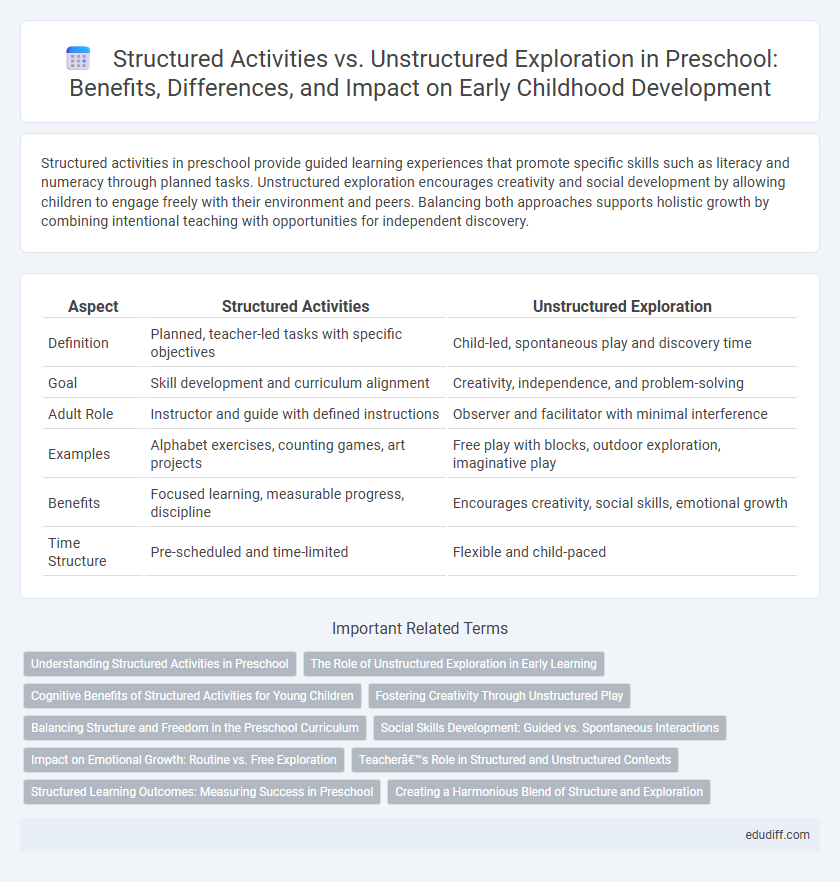Structured activities in preschool provide guided learning experiences that promote specific skills such as literacy and numeracy through planned tasks. Unstructured exploration encourages creativity and social development by allowing children to engage freely with their environment and peers. Balancing both approaches supports holistic growth by combining intentional teaching with opportunities for independent discovery.
Table of Comparison
| Aspect | Structured Activities | Unstructured Exploration |
|---|---|---|
| Definition | Planned, teacher-led tasks with specific objectives | Child-led, spontaneous play and discovery time |
| Goal | Skill development and curriculum alignment | Creativity, independence, and problem-solving |
| Adult Role | Instructor and guide with defined instructions | Observer and facilitator with minimal interference |
| Examples | Alphabet exercises, counting games, art projects | Free play with blocks, outdoor exploration, imaginative play |
| Benefits | Focused learning, measurable progress, discipline | Encourages creativity, social skills, emotional growth |
| Time Structure | Pre-scheduled and time-limited | Flexible and child-paced |
Understanding Structured Activities in Preschool
Structured activities in preschool provide children with guided learning experiences that promote cognitive, social, and fine motor skills development. These activities are designed with specific educational goals, such as counting exercises or letter recognition, allowing educators to monitor progress and tailor instruction. By integrating consistent routines and clear objectives, structured activities support early childhood development through focused skill-building in a classroom setting.
The Role of Unstructured Exploration in Early Learning
Unstructured exploration in early childhood fosters creativity, critical thinking, and social skills by allowing children to engage with their environment at their own pace. This form of learning supports cognitive development through hands-on experiences that enhance problem-solving abilities and sensory awareness. Research shows that free play promotes emotional regulation and independence, making it a vital component of preschool education alongside structured activities.
Cognitive Benefits of Structured Activities for Young Children
Structured activities in preschool provide targeted cognitive benefits by promoting skills such as memory, attention, and problem-solving through guided tasks designed to challenge young learners. These activities support executive function development, enabling better impulse control and task persistence, which are crucial for academic success. Consistent participation in structured learning environments helps children build foundational cognitive abilities that enhance language acquisition, reasoning, and early math skills.
Fostering Creativity Through Unstructured Play
Unstructured exploration in preschool plays a crucial role in fostering creativity by allowing children to engage freely with their environment, encouraging imagination and problem-solving skills. Unlike structured activities that follow predetermined guidelines, unstructured play promotes cognitive flexibility and emotional development through self-directed discovery. Research shows that this open-ended play supports neural growth and helps develop executive functions essential for lifelong learning.
Balancing Structure and Freedom in the Preschool Curriculum
Balancing structure and freedom in the preschool curriculum fosters cognitive, social, and emotional development by integrating planned, goal-oriented activities with child-led exploration. Research shows that structured activities provide essential skill-building opportunities, while unstructured play encourages creativity and problem-solving, enhancing neural development. Effective preschool programs strategically blend both approaches to support diverse learning styles and promote holistic growth.
Social Skills Development: Guided vs. Spontaneous Interactions
Structured activities in preschool promote social skills development through guided interactions led by teachers, fostering cooperation, turn-taking, and communication within clear frameworks. Unstructured exploration encourages spontaneous peer interactions, enabling children to practice conflict resolution, negotiation, and empathy in authentic, child-initiated contexts. Balancing both approaches maximizes social competence by combining deliberate skill-building with natural, self-directed social experiences.
Impact on Emotional Growth: Routine vs. Free Exploration
Structured activities in preschool provide a consistent routine that fosters emotional security and self-discipline, essential for early emotional regulation. Unstructured exploration encourages creativity and independence, allowing children to express feelings and develop problem-solving skills organically. Balancing routine-based tasks with free exploration supports a well-rounded emotional growth, promoting resilience and confidence in young learners.
Teacher’s Role in Structured and Unstructured Contexts
Teachers in preschool settings play a crucial role in balancing structured activities and unstructured exploration to support holistic child development. During structured activities, educators guide learning with clear objectives, scaffolding skills such as literacy, numeracy, and social interaction. In unstructured exploration, teachers facilitate a safe environment that encourages creativity, problem-solving, and autonomy while observing and subtly supporting children's interests and discoveries.
Structured Learning Outcomes: Measuring Success in Preschool
Structured activities in preschool are designed with clear learning objectives that facilitate measurable outcomes in cognitive, social, and motor development. These activities enable educators to systematically assess progress through standardized tools and observational checklists, ensuring targeted skill acquisition. Emphasizing structured learning outcomes supports early identification of developmental milestones and tailored interventions for preschool children.
Creating a Harmonious Blend of Structure and Exploration
Balancing structured activities with unstructured exploration fosters optimal preschool development by promoting cognitive skills and creativity simultaneously. Structured tasks enhance skill-building and focus, while unstructured play encourages imagination, problem-solving, and social interaction. Integrating these approaches ensures a harmonious learning environment that supports holistic growth in early childhood education.
Structured Activities vs Unstructured Exploration Infographic

 edudiff.com
edudiff.com